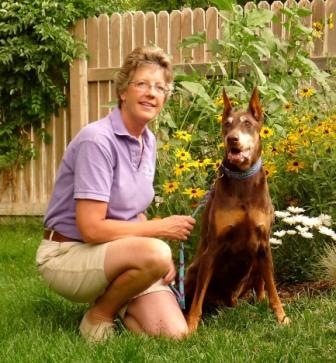
Gift of longevity brings surprises and challenges
Aging has been on my mind lately—my own, but especially that of dogs. Several of my friends have lost their old, and not so old, dogs this past year. My Solo turns 13 on the Fourth of July. That’s getting up there for any dog, but for a Doberman, it’s phenomenal. Sadly, the current average for the breed is only 8 to 10 years. I lost two at around 8, and Solo had a health crisis at that age that had me sure I would lose him too. But we’ve been granted extra time together.
You would think I would just be grateful and happy. But life with Solo hasn’t been easy. He has been a “special needs” dog from the beginning. I didn’t plan it that way. His father was the No. 2 Doberman in the country when I got him. I had planned to compete in conformation and agility. I had planned on him being my “everything” dog. The Universe had other plans.
Solo presented me with new challenges every day, week, month for the first five-plus years—a health issue, extreme fear, reactivity in all its forms, some aggression toward my other dog, and a depth of sensitivity I had not experienced up to then. He barked—a lot. He worried, and was constantly in motion. He sucked his blanket. He didn’t like other people or dogs. He regularly pushed me to the edge of my knowledge, comfort zone, and patience. I had many people tell me to “send him back.” Instead, I just kept experimenting, learning, and working to gain his trust and calm his fears. I had to learn to listen to him on a deep level and to trust myself to hear him. It was a very slow process for both of us.
Moving to Corrales was a leap of faith. My other Doberman died suddenly just months before. Solo was used to a life of solitude in the country. How would he handle seeing strange dogs and people on our walks? It was a whole new set of challenges and learning for us.
I’m happy to report that he has done remarkably well. He actually has some dog friends here, and seems generally more relaxed. Perhaps he has finally learned to let go, or he has just mellowed with age. Perhaps having my undivided attention as an only dog has eased his insecurities. He’s still my “special needs” boy, but he requires a lot less managing than he once did. That’s not to say that he has become a Golden Retriever or Labrador. Oh, no. He’s still very much a Doberman—intense, intelligent, loyal—and there are still many things he can’t do. You won’t see him at the Fourth of July parade, the Grower’s Market, or Art in the Park. That stuff is too much for him to handle. But you might catch us walking the ditches or levee at a quiet time.
Transitioning
While his behavior has mellowed, and I can relax more about that, Solo is my first “old dog.” That has brought some new changes and gifts. He’s incredibly sweet and funny now. He sleeps more. He has more lumps and bumps than you can count. Some past issues with his liver and digestion continue to give him trouble at times—which leads to sleepless nights for both of us. He has arthritis in his front feet and is slowly losing muscle mass and strength. Despite a life of raw foods, his teeth are wearing out.
In an effort to educate myself about the aging process for dogs, I recently viewed the video Winding Down by Dr. Karen Becker, a holistic vet in the Chicago area. This DVD was a treasure trove of useful information. While specifically aimed at owners of geriatric animals, the information also helps owners of younger dogs make better choices to help keep them healthy into their senior years. Here are a few highlights:
- Dogs need a varied diet of fresh, whole foods. While a species-appropriate diet of raw meat and bones is optimal for our dogs (and cats), even a prepared diet can be improved with the addition of raw foods.
- They need clean air and pure water. If there are smokers in the home, an air purifier will reduce the pet’s exposure to second-hand smoke. Filtered or purified water is available in many forms for us and our pets.
- We need to reduce their exposure to toxins, chemicals, preservatives, and other obstacles to good health. Make informed choices about all vaccinations and the use of flea and heartworm products.
- Our animals “break” at the weakest link. So things that happen in their youth can give us an inkling of their weak spots—accident, injury, surgery, chronic infections, sensitive digestion, pulling on leash, jumping off furniture, and chronic reactivity can all lead to weakening of the body. As we recognize this, we can take steps to mitigate the damage with supplements, preventive care, and training.
- Regular checkups and a good relationship with the veterinarian are vital to a pet’s health. As our pets age, they need more frequent checkups and regular blood work to monitor their health.
- There are many complementary modalities that can benefit a pet’s health. We are fortunate to have access to a wide variety of them, including acupuncture/acupressure, chiropractic, TTouch, massage, Healing Touch for Animals, flower essences, herbs, nutraceuticals, etc.
- Most older animals can benefit from the addition of digestive enzymes, probiotics, anti-inflammatory supplements and acid reducers. I chose the N-Zymes system for Solo.
- Despite all that we may be able to do for our pets, we must also be respectful of their spirit and desires. That may mean not adding another supplement, treatment, or surgery and accepting that they have a voice in deciding the length and quality of their lives.
- Dr. Becker suggests creating an “autumn file” for our animals—a collection of information on aging and pertinent health issues, along with our plans for how we want them to be treated (or not)—sort of like “Do Not Resuscitate” decisions for humans. Preplanning while our dogs are healthy saves us from feeling overwhelmed and making rash decisions during a crisis.
The next phase
That brings me back to feeling grateful for the extra time I have had with Solo. He has been one of my greatest teachers, and continues to teach me new things every day. I will never forget the powerful influence he has had on me, both as a dog trainer and a person. I don’t know how many more lessons the Universe has left for Solo to teach me, but I will be very sad when his time to transition finally arrives.
I know that when he is gone, I will be making a transition as well. I will have more freedom to open my home to friends, to travel more freely, to relax more deeply without the ever-present responsibility of keeping him safe. In time, there will be a new puppy to present me with challenges, to teach me, to bring me joy.
For now, I am patient. I concentrate on soaking him in—listening to him breathe, playing games, exchanging kisses, sharing treats. He has always been “larger than life,” so I know his spirit will live on in me, and my experiences with him will continue to help me teach others what he has taught me. I suspect that the final lessons will be just as bittersweet as those that have gone before.
